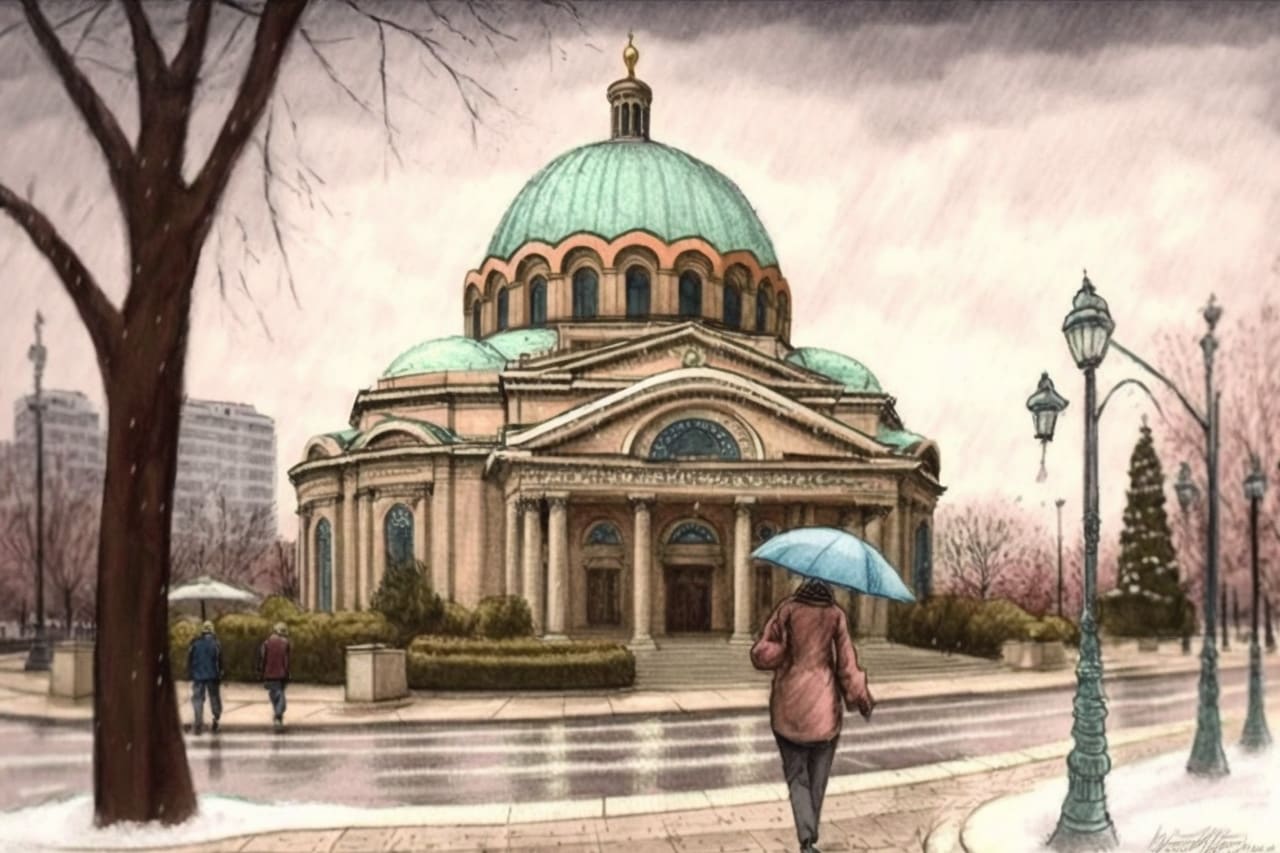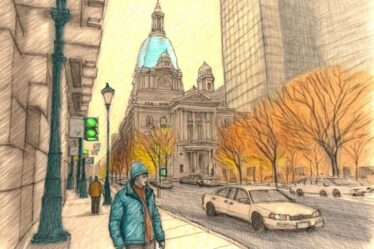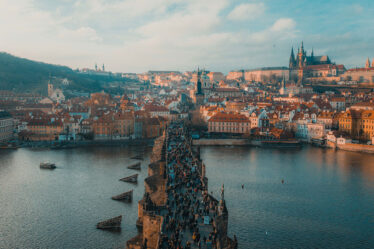
As the world slowly awakens from the icy grip of winter, Sofia – Bulgaria’s capital city- starts to bloom in March, offering a delightful mix of history, culture, and the promise of spring.
The Arrival
On landing in Sofia, I was greeted by a lovely blend of snow-capped mountains and the faint whispers of spring. Sofia’s airport, though not as bustling as New York’s JFK or London’s Heathrow, had a unique charm that was both welcoming and soothing.
The first thing that struck me about Sofia was its eclectic mix of old and new. Byzantine, Ottoman, and Soviet architectures stand side by side with modern buildings, creating an intriguing skyline. It was like flipping through the pages of a history book, with each era leaving its indelible mark on the city.
Sofia’s Historical Heritage
As a history buff, I found Sofia to be a treasure trove. My first stop was the St. Alexander Nevsky Cathedral. This magnificent structure, with its gold-domed roof, could be seen from almost any point in the city. Inside, I was captivated by the intricate frescoes and mosaics that adorned the walls and ceiling. The sense of peace and tranquility inside the cathedral was overwhelming.
After the cathedral, I visited the Roman-era Serdica ruins, conveniently located in the city center. Walking through the ruins, I could almost hear the echoes of the past. It was fascinating to see the remains of an ancient city nestled within a modern city.
Sofia’s Delicious Cuisine
Sofia’s cuisine was another highlight of my trip. Bulgarian food is hearty and flavorful, with a generous use of fresh vegetables, cheese, and spices. Shopska salad, a delightful mix of tomatoes, cucumbers, onions, and cheese, quickly became a favorite of mine. I also took the opportunity to indulge in some traditional Bulgarian pastries, like banitsa.
One of my memorable culinary experiences was at the Made in Home restaurant. This cozy eatery, with its warm and friendly staff, offered an excellent selection of Bulgarian and European dishes. I particularly enjoyed their homemade bread, served warm with a variety of dips.
The Spirit of Sofia
What truly sets Sofia apart is its spirit. The people of Sofia are warm, welcoming, and proud of their city. They are always willing to share stories about Sofia’s history and culture. As a visitor, I felt a sense of belonging and warmth that made my trip even more enjoyable.
One such encounter was with an elderly gentleman at a local café. We struck up a conversation, and he shared stories about Sofia’s past, its transformation over the years, and his hopes for the future. It was these personal interactions that made my trip memorable.
Sofia in March
Visiting Sofia in March was a delight. The weather was a pleasant mix of winter’s chill and spring’s warmth. The parks were starting to show the first signs of spring, with blooming flowers and trees. It’s a wonderful time to visit Sofia, with fewer tourists and more opportunities to interact with the locals.
One of my favorite experiences was a walk in Borisova Gradina, Sofia’s oldest and largest park. The park was quiet, with only a few locals enjoying the early spring sunshine. The park’s lake was still partially frozen, creating a beautiful contrast with the budding trees around it.
Wrapping Up
My trip to Sofia was a delightful journey through history, culture, and cuisine. The city’s eclectic mix of old and new, its delicious food, and its warm and welcoming people left a lasting impression on me.
As the plane took off for my next adventure, I looked down at the city one last time. The golden domes of the St. Alexander Nevsky Cathedral were gleaming in the sunlight. Sofia, with its unique charm and character, had captured a piece of my heart. I knew I would return someday to explore more of its hidden gems.
So, if you’re planning your next travel adventure, consider Sofia. It’s a city that will surprise you, delight you, and make you fall in love with its charm. Happy travels!
Must-see Destinations for Sofia Bulgaria in March
| Destination | Description |
|---|---|
| Alexander Nevsky Cathedral | One of the largest Eastern Orthodox cathedrals in the world and Sofia’s main tourist attraction. |
| Vitosha Mountain and Ski Resort | A great place for skiing and snowboarding, with plenty of scenic views. |
| Boyana Church | A medieval Bulgarian Orthodox church listed as a UNESCO World Heritage site, known for its well-preserved frescoes. |
| National Museum of History | Offers a broad spectrum of exhibits from prehistoric times, through the middle ages, to the modern era. |
| Sofia Zoo | The oldest and largest zoological garden in the Balkans. |
| Vitosha Boulevard | Sofia’s main shopping street, filled with boutiques, cafes, and street performers. |
| Borisova Gradina | The oldest and best known park in Sofia, perfect for a peaceful walk. |
| Ivan Vazov National Theater | Bulgaria’s national theater and one of the important landmarks of Sofia. |
| The Rotunda of St George | The oldest building in Sofia, featuring impressive architecture and historical significance. |
| The Sofia Synagogue | The third largest synagogue in Europe, showcasing the city’s diverse religious history. |
| The Earth and Man National Museum | One of the biggest mineralogical museums in the world, housing a collection of giant crystals, gems and prehistoric flora. |
Top Tips for Visiting Sofia, Bulgaria in March
- Pack Warm Clothes: March in Sofia can still be quite chilly, with temperatures ranging between 5 to 10 degrees Celsius during the day. Evenings can be freezing, so be sure to pack warm clothes, such as thermal tops, sweaters, a heavy coat, scarves and gloves.
- Visit Vitosha Mountain: If you love winter sports, Vitosha Mountain is a must-visit in March. It offers great skiing and snowboarding opportunities. Don’t forget to bring your winter sports gear!
- Explore Sofia’s Museums and Galleries: Sofia is rich in history and culture. Visiting museums and galleries, like the National Museum of History and the Sofia Art Gallery, is a great way to spend a cold day indoors.
- Try Local Cuisine: Sofia has many cozy restaurants where you can try traditional Bulgarian food. Popular dishes include Shopska Salad, Tarator, and Banitsa. Sip on a warm Rakia (a fruit brandy popular in the Balkans) to keep the cold at bay.
- Use Public Transportation: Sofia’s public transportation is reliable and cheap. It’s a great way to get around the city and see the sights.
- Take a City Tour: Join a free walking tour to familiarize yourself with Sofia’s history and iconic landmarks. These tours usually start at the Palace of Justice.
- Visit Religious Sites: Sofia is home to several beautiful churches, such as the Alexander Nevsky Cathedral, the Church of St. George, and the Boyana Church. Remember to dress respectfully when visiting these sites.
- Stay Hydrated: The air in Sofia can be quite dry in March, so it’s important to drink plenty of water to stay hydrated and avoid chapped lips and skin.
- Visit Local Markets: Sofia’s local markets, such as the Ladies’ Market and the Central Market Hall, are vibrant places to buy fresh produce, traditional Bulgarian products, and souvenirs.
- Currency Exchange: The local currency is the Lev (BGN). It’s best to exchange your money at a bank or a reputable exchange office to get the best rates.
Remember, these are just guidelines. Sofia, like any city, can surprise you with unexpected weather or events, so it’s always good to be flexible and adaptable in your plans. Happy travels!


